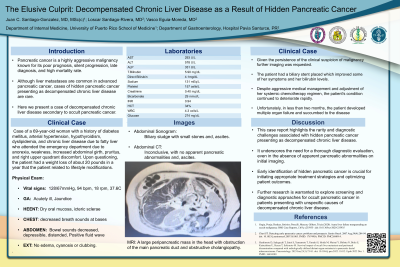Tuesday Poster Session
Category: Biliary/Pancreas
P2927 - The Elusive Culprit: Decompensated Chronic Liver Disease as a Result of Hidden Pancreatic Cancer
Tuesday, October 24, 2023
10:30 AM - 4:00 PM PT
Location: Exhibit Hall

Has Audio

Juan Carlos Santiago-Gonzalez, MD, MSc
University of Puerto Rico School of Medicine
Caguas, Puerto Rico
Presenting Author(s)
Juan C. Santiago-Gonzalez, MD, MSc1, Vasco Eguia-Moreda, MD2, Loscar Santiago-Rivera, MD3
1University of Puerto Rico School of Medicine, Caguas, Puerto Rico; 2Hospital Pavia Santurce, San Juan, Puerto Rico; 3San Juan, Puerto Rico
Introduction: Pancreatic cancer is a highly aggressive malignancy known for its poor prognosis, silent progression, late diagnosis, and high mortality rate. Although liver metastases are common in advanced pancreatic cancer, cases of hidden pancreatic cancer presenting as decompensated chronic liver disease are rare. Here we present a case of decompensated chronic liver disease secondary to occult pancreatic cancer.
Case Description/Methods: Case of a 69-year-old woman with a history of diabetes mellitus, arterial hypertension, hypothyroidism, dyslipidemia, and chronic liver disease due to fatty liver who attended the emergency department due to anorexia, weakness, increased abdominal girth, pruritus, and right upper quadrant discomfort. Stable vital signs, but a physical exam showed a positive fluid wave and jaundice. Laboratories showed bilirubin around 5.90mg/dL being indirectly 4.1mg/dL the predominant, with AST at 293 U/L and ALT at 578 U/L and sodium at 128 mmol/L. The abdominal sonogram showed biliary sludge with small stones. Recent abdominal CT was inconclusive, with no apparent pancreatic abnormalities. Upon questioning, the patient had a weight loss of about 20 pounds in a year that the patient related to lifestyle modifications. However, given the persistence of the clinical suspicion of malignancy, MRI and MRCP were performed, which showed a large peripancreatic mass in the head with obstruction of the main pancreatic duct and obstructive cholangiopathy. The biomarker CA 19-9 was 5000 U/mL. The patient had a biliary stent placed which improved some of her symptoms and her bilirubin levels. Despite aggressive medical management and adjustment of his systemic chemotherapy regimen, the patient's condition continued to deteriorate rapidly. Unfortunately, in less than two months, the patient developed multiple organ failure and succumbed to the disease.
Discussion: This case report highlights the rarity and diagnostic challenges associated with hidden pancreatic cancer presenting as decompensated chronic liver disease. It underscores the need for a thorough diagnostic evaluation, even in the absence of apparent pancreatic abnormalities on initial imaging. Early identification of hidden pancreatic cancer is crucial for initiating appropriate treatment strategies and optimizing patient outcomes. Further research is warranted to explore screening and diagnostic approaches for occult pancreatic cancer in patients presenting with unspecific causes of decompensated chronic liver disease.
Disclosures:
Juan C. Santiago-Gonzalez, MD, MSc1, Vasco Eguia-Moreda, MD2, Loscar Santiago-Rivera, MD3. P2927 - The Elusive Culprit: Decompensated Chronic Liver Disease as a Result of Hidden Pancreatic Cancer, ACG 2023 Annual Scientific Meeting Abstracts. Vancouver, BC, Canada: American College of Gastroenterology.
1University of Puerto Rico School of Medicine, Caguas, Puerto Rico; 2Hospital Pavia Santurce, San Juan, Puerto Rico; 3San Juan, Puerto Rico
Introduction: Pancreatic cancer is a highly aggressive malignancy known for its poor prognosis, silent progression, late diagnosis, and high mortality rate. Although liver metastases are common in advanced pancreatic cancer, cases of hidden pancreatic cancer presenting as decompensated chronic liver disease are rare. Here we present a case of decompensated chronic liver disease secondary to occult pancreatic cancer.
Case Description/Methods: Case of a 69-year-old woman with a history of diabetes mellitus, arterial hypertension, hypothyroidism, dyslipidemia, and chronic liver disease due to fatty liver who attended the emergency department due to anorexia, weakness, increased abdominal girth, pruritus, and right upper quadrant discomfort. Stable vital signs, but a physical exam showed a positive fluid wave and jaundice. Laboratories showed bilirubin around 5.90mg/dL being indirectly 4.1mg/dL the predominant, with AST at 293 U/L and ALT at 578 U/L and sodium at 128 mmol/L. The abdominal sonogram showed biliary sludge with small stones. Recent abdominal CT was inconclusive, with no apparent pancreatic abnormalities. Upon questioning, the patient had a weight loss of about 20 pounds in a year that the patient related to lifestyle modifications. However, given the persistence of the clinical suspicion of malignancy, MRI and MRCP were performed, which showed a large peripancreatic mass in the head with obstruction of the main pancreatic duct and obstructive cholangiopathy. The biomarker CA 19-9 was 5000 U/mL. The patient had a biliary stent placed which improved some of her symptoms and her bilirubin levels. Despite aggressive medical management and adjustment of his systemic chemotherapy regimen, the patient's condition continued to deteriorate rapidly. Unfortunately, in less than two months, the patient developed multiple organ failure and succumbed to the disease.
Discussion: This case report highlights the rarity and diagnostic challenges associated with hidden pancreatic cancer presenting as decompensated chronic liver disease. It underscores the need for a thorough diagnostic evaluation, even in the absence of apparent pancreatic abnormalities on initial imaging. Early identification of hidden pancreatic cancer is crucial for initiating appropriate treatment strategies and optimizing patient outcomes. Further research is warranted to explore screening and diagnostic approaches for occult pancreatic cancer in patients presenting with unspecific causes of decompensated chronic liver disease.
Disclosures:
Juan Santiago-Gonzalez indicated no relevant financial relationships.
Vasco Eguia-Moreda indicated no relevant financial relationships.
Loscar Santiago-Rivera indicated no relevant financial relationships.
Juan C. Santiago-Gonzalez, MD, MSc1, Vasco Eguia-Moreda, MD2, Loscar Santiago-Rivera, MD3. P2927 - The Elusive Culprit: Decompensated Chronic Liver Disease as a Result of Hidden Pancreatic Cancer, ACG 2023 Annual Scientific Meeting Abstracts. Vancouver, BC, Canada: American College of Gastroenterology.
